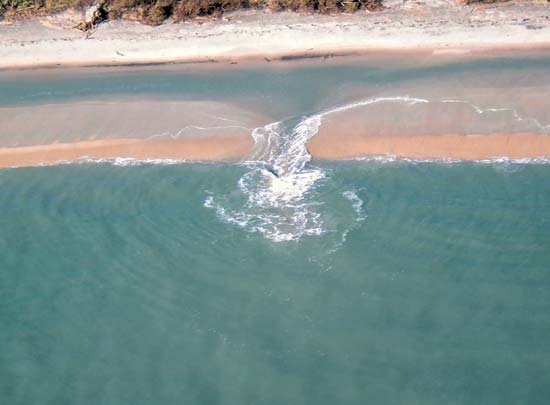PSA: One of the Deadliest Things Found at the Beach
I typed this post up around December and planned for this to be one of my first posts, but since it is vacation season in the United States, I thought I would wait until now to post.
Rip Currents
One of the most incredible, yet scary, things about the ocean is the ability for rip currents to form. Many people refer to these as a "rip tide" or an "undertow," both of these are incorrect. No one will judge you for this mistake as even the Weather Channel gets it wrong.
As NOAA says,
While the terms are often confused, rip currents are different than rip tides. A riptide is a specific type of current associated with the swift movement of tidal water through inlets and the mouths of estuaries, embayments, and harbors.
What is a Rip Current?
A rip current is a strong, narrow current from the beach towards the ocean (or lake if it is large enough for waves to form and break). This current can reach speeds of up to 2.5 meters per second but is typically less than 1 meter per second.
How do Rip Currents Form?
To answer this, I'm going to refer to a post from LiveScience.com
There are many different types of rip currents, and they form in several ways. Quickly changing wave heights, which occur when a large set of swells rolls in, can trigger a rip current. Rip currents can also occur at spots where there's a break in a sandbar; there, water is funneled out to sea. These channels in sandbars lie just off the beach. When water returns to the ocean, it follows the path of least resistance, which is typically through these channels. Strong rip currents also often appear next to structures such as piers, jetties, and groins.
It basically comes down to having some sort of breaking waves. Once the wave breaks, the water goes back to sea. If two waves break simultaneously or close to it, the potential for a rip current is there.
What to do if you're caught in a rip current?
There are a few different things one can do if they find themselves caught in a rip current: let the current take you, swim against the current or swim horizontally out of the current.
Let's start with the one that is most likely to get you killed: swimming against the current. Why is this a bad idea? Well, the current is stronger than you. I.E you will not power through this. The current will tire you and your muscles out to the point of almost complete exhaustion typically causing people to drown if someone else cannot get to them in enough time.
The other two things are favorable as they are not nearly as tiring and can actually save your ass if you get caught in one of these currents. Swimming horizontally with the shore will ensure that you're not trying to fight the current. You will eventually make it outside of the current and be able to swim directly to shore. Likewise, once you let the current take you out, you're able to swim horizontally until you are out of the current's path then swim towards the shore.
Rip Current Videos
This section is just in case you've never seen a rip current, enjoy.
This one calls it a "rip tide" but ignore that, he is just confused on terminology.
Sources:
http://www.ripcurrents.noaa.gov/brochures/rip_brochure_final.pdf
https://oceanservice.noaa.gov/facts/ripcurrent.html
https://oceantoday.noaa.gov/ripcurrentscience/
http://www.ripcurrents.noaa.gov/science.shtml
https://science.howstuffworks.com/environmental/earth/oceanography/rip-current.htm
https://www.livescience.com/3910-rip-currents-ocean-deadliest-trick.html
http://www.ripcurrents.com/ripcurrents101.html
https://www.youtube.com/watch?v=PuAlDTC_gIQ
https://www.youtube.com/watch?v=Io-U-ZOuYYc
https://www.youtube.com/watch?v=UY-cl1q-JKQ


.gif)
This post is a good public service announcement, just in time for Summer in the Northern Hemisphere.
@branbello you were flagged by a worthless gang of trolls, so, I gave you an upvote to counteract it! Enjoy!!
Thank you!
Congratulations @branbello! You received a personal award!
Click here to view your Board of Honor
Do not miss the last post from @steemitboard:
Congratulations @branbello! You received a personal award!
You can view your badges on your Steem Board and compare to others on the Steem Ranking
Vote for @Steemitboard as a witness to get one more award and increased upvotes!